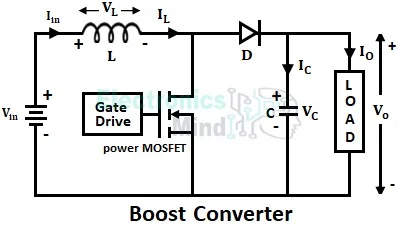Due to the advancement in the usage of battery and solar energy, power electronic converters play a major role in various electronic applications. The dc choppers or dc-to-dc converters are the most widely used electronic converters in electronic equipment and systems due to their high quality, lightweight, reliable, and efficient power supplies.
There are various types of dc-to-dc converters by which we can obtain desired regulated power supply. In this article let us learn about buck and boost converters with comparison.
Buck Converter :
A buck converter is a type of dc-to-dc converter by which we can control the output voltage from zero to the input voltage level. In other words, a buck converter is similar to a step-down transformer whose average output voltage is less than the input voltage. The below shows the circuit topology of the buck converter.
When the transistor (switch) is ON, the diode will be reverse biased and the source will supply power to the load as well as to the inductor. When the transistor is OFF, the source will be disconnected from the load and the inductor will supply its stored energy to load through the diode.
The inductor will discharge until the transistor is switched ON again. In this way, by controlling the switching period of the transistor we can regulate the output voltage of the buck converter.
Boost Converter :
A boost converter is also a type of dc-to-dc converter in which the output voltage is greater than the input voltage. In simple, a boost converter is a step-up dc-to-dc converter that increases the level of input voltage at the output side. The below shows the circuit topology of the boost converter.
When the transistor is ON, the inductor will be charged by the source through the transistor, and the diode will be reverse-biased. When the transistor is switched OFF, the load receives voltage from the source and as well inductor through the diode. By changing the duty ratio of the circuit, the output voltage can be regulated.
Difference Between Buck Converter and Boost Converter :
| Parameter | Buck Converter | Boost Converter |
|---|---|---|
| Definition | Buck converter is a step-down type dc-to-dc converter that gives an output voltage lesser than the input voltage. | Boost converter is a step-up type dc-to-dc converter that gives an output voltage greater than the input voltage. |
| Output voltage | Low | High |
| Output current | High | low |
| Nature of input current | Discontinuous | Continuous |
| Output voltage (Vout) equation | Vout = Vin × Duty Cycle | Vout = Vin/(1 – Duty Cycle) |
| Output current (Iout) equation | Iout = Iin/Duty Cycle | Iout = Iin(1 – Duty Cycle) |
| Filter requirement | Large filter is required. | Small filter is required. |
| Inductor Usage | The inductor helps in limiting di/dt during a fault condition of the load. | The inductor helps in limiting di/dt during a fault condition of the switch. |
| Applications | Telecommunications, battery-operated equipment, solar charges, etc. | Power amplifiers, consumer Electronics, communication applications, automotive applications, etc. |


